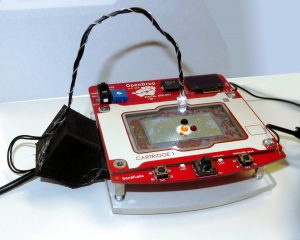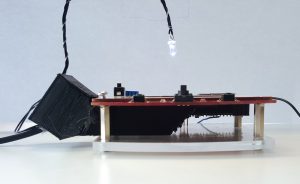The electrodes of the OpenDrop devices are designed with pass though holes in their center to connect the electrode to the drive circuit on the back side of the circuit board. This hole can also be used to optically inspect the droplet sitting on the electrode. This can be though a simple light senor on the bottom of the electrode with a reference light such as a light emitting diode (LED) on top. Or it can be developed into a full spectrometer to measure the absorbance of the liquid drop. Optical spectrometry has many application in characterizing biological samples such as measuring growth curves of bacteria.
A simple 3D printable spectrometer was developed that fits with the OpenDrop V2. The DIY design is based on the PublicLabs Spectrometer using a conventional computer WebCam as a sensor and a piece of DVD as a diffraction grating. PublicLabs also offers a great online tool to measure, calibrate and quantify the spectrum captured with the WebCam that can also be used with the OpenDrop Spectrometer.


OpenDrop with spectrometer connected to a computer running a webcam software.


Close up and side view of the build. An white LED provides the light from the top. For a more stable setup this could be integrated into the device.

Image of spectrum captured by the webcam. The spectrum of 3 electrode holes is visible. For calibration a fluorescent light bulb was shined on the electrodes. The characteristic lines are from the mercury and phosphors in the lamp.

Measurement taken on the OpenDrop with the SpectralWorkbench online software.

3D printing parts for the spectrometer


